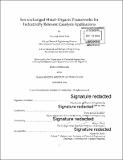| dc.contributor.advisor | Yuriy Román-Leshkov and Mircea Dincă. | en_US |
| dc.contributor.author | Park, Hoyoung Daniel. | en_US |
| dc.contributor.other | Massachusetts Institute of Technology. Department of Chemical Engineering. | en_US |
| dc.date.accessioned | 2020-02-10T21:39:07Z | |
| dc.date.available | 2020-02-10T21:39:07Z | |
| dc.date.copyright | 2019 | en_US |
| dc.date.issued | 2019 | en_US |
| dc.identifier.uri | https://hdl.handle.net/1721.1/123728 | |
| dc.description | Thesis: Ph. D., Massachusetts Institute of Technology, Department of Chemical Engineering, 2019 | en_US |
| dc.description | Cataloged from PDF version of thesis. | en_US |
| dc.description | Includes bibliographical references. | en_US |
| dc.description.abstract | The inorganic clusters of metal-organic frameworks (MOFs) offer a unique combination of synthetic tunability, structural uniformity, and site accessibility uncommon in conventional heterogeneous catalysts. As such, the inorganic nodes of MOFs provide a promising platform that can be engineered to promote challenging chemical transformations for which no adequate solid catalysts exist. This thesis focuses on the postsynthetic ion exchange behavior of the inorganic nodes in MOFs and its use in the preparation of ion-exchanged MOF catalysts for industrially relevant chemical transformations. Chapter 1 introduces the characteristics of MOFs relevant to heterogeneous catalysis and highlights their structural tunability with an emphasis on their node ion exchange behavior. | en_US |
| dc.description.abstract | Chapter 2 details the application of the postsynthetic ion exchange strategy in the preparation of Co(CO)₄⁻- incorporated Cr-MIL-101 (Co(CO)₄cCr- MIL-101, Cr-MIL-101 = Cr₃O(BDC)₃F, H₂BDC = 1,4-benzenedicarboxylic acid), the first heterogeneous catalyst for epoxide carbonylation. Chapters 3 and 4 outline the use of Co(CO)₄ cCr-MIL-101 in a fixed-bed reactor process for the continuous-flow carbonylative production of [beta]-lactone and succinic anhydride, respectively. Chapter 5 describes the use of Cr³⁺-exchanged MFU- 4l (Cr-MFU-4l, MFU- 4l = Zn₅Cl₄(BTDD)₃, H₂BTDD = bis(1H-1,2,3,-triazolo[4,5-b],[4',5'-i])dibenzo[1,4]dioxin)) as an exemplary system to demonstrate pre-reaction treatment with alkylaluminum species as a simple method to isolate a MOF catalyst for gas phase ethylene polymerization. | en_US |
| dc.description.abstract | The favorable performance of these MOF catalysts underscores the intrinsic advantages of their inorganic nodes, which support precise coordination geometries as isolated single sites within a porous scaffold for novel catalytic applications. Combined with the high structural tunability of the node metal sites, the inorganic clusters of MOFs hold tremendous potential for rational catalyst design. | en_US |
| dc.description.statementofresponsibility | by Hoyoung Daniel Park. | en_US |
| dc.format.extent | 157 pages | en_US |
| dc.language.iso | eng | en_US |
| dc.publisher | Massachusetts Institute of Technology | en_US |
| dc.rights | MIT theses are protected by copyright. They may be viewed, downloaded, or printed from this source but further reproduction or distribution in any format is prohibited without written permission. | en_US |
| dc.rights.uri | http://dspace.mit.edu/handle/1721.1/7582 | en_US |
| dc.subject | Chemical Engineering. | en_US |
| dc.title | Ion-exchanged metal-organic frameworks for industrially relevant catalysis applications | en_US |
| dc.type | Thesis | en_US |
| dc.description.degree | Ph. D. | en_US |
| dc.contributor.department | Massachusetts Institute of Technology. Department of Chemical Engineering | en_US |
| dc.identifier.oclc | 1138462625 | en_US |
| dc.description.collection | Ph.D. Massachusetts Institute of Technology, Department of Chemical Engineering | en_US |
| dspace.imported | 2020-02-10T21:39:06Z | en_US |
| mit.thesis.degree | Doctoral | en_US |
| mit.thesis.department | ChemEng | en_US |
